Florence - Following in Galileo's tracks
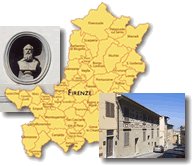
Galileo lived in Florence most of his life. He spent his adolescence there completing his early studies, and established himself there permanently when he was appointed as First Mathematician and Philosopher to the Grand Duke of Tuscany. Some of the places where he resided have vanished without a trace, and there is scarce mention of them even in letters and documents, while others have survived intact, along with the sites and monuments associated in some way with the often stormy adventures of his life.
The Dominican Tommaso Caccini, who during the religious functions he officiated in the Basilica of Santa Maria Novella attacked Galileo for favoring the Copernican system, wound up testifying against him voluntarily before the Holy Office and was one of the main instigators of the trial against Galileo which took place in 1616.
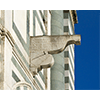
The Basilica of Santa Maria Novella constitutes a concrete example of the close relationship between science and art. In the second half of the 15th century, Leon Battista Alberti was entrusted with completing the facade, where he admirably harmonised the medieval elements and the new parts contained in his project. The relationships of the parts amongst themselves and with the entirety are established by a harmonic proportional system derived from simple ratios (one to one, one to two, one to three, etc.), which are at the basis of musical harmony. This system permitted Alberti to define the position and dimension of every element of the facade. The one-to-two relationship governs the composition of the entire facade, which appears inscribed in a square, while a smaller square (with sides equal to half that of the larger square) establishes the relationship between the two floors, breaks up the lower part, and circumscribes the upper central part. This ratio is maintained for all the elements of the facade, so that it appears built geometrically on the basis of a progressive halving or doubling of the measurements, always maintaining the same proportion.
The Basilica interior houses the famous Trinità by Masaccio which, formulated within an architectural space conceived according to the perspective laws of Filippo Brunelleschi, constitutes another example of the happy union between drawing science and artistic expression.
In the second half of the 16th century, the astronomer, mathematician and geographer at the court of Cosimo I de' Medici, Egnazio Danti placed two astronomical instruments on the facade, which he used to study the apparent motion of the Sun. On the left are two equinoctial circles, while on the right is a quadrant with two sundials on the base. On the marble squares of the facade, to either side of the quadrant, are two carved sundials. The calculations Danti made were important to correct the calendar used until then. The new calendar, known as Gregorian, after Pope Gregory XIII who promoted the reform, established that October 4, 1582 would be immediately followed by October 15. This stratagem corrected a small error present in the calendar promoted by Julius Cesar and known as the Julian calendar. In the same church, Danti also started, but did not finish, the construction of a monumental sundial. Above the rose window, in the green fascia, in the middle, we can still see the gnomonic hole through which a sunbeam was to strike the meridian altitude on the floor inside the church.
The church is also associated to the figure of Galileo Galilei. From the pulpit of the church, in December 1614, Dominican Tommaso Caccini denounced the heretical nature of the Copernican system, also involving Galileo who was a supporter. Several of the Pisan scientist's followers reacted to this, and Caccini reported to the Inquisitor of Florence requesting he repress «certain insolent intellectuals». In his letters to Benedetto Castelli in 1613 and to Christine of Lorraine in 1615, Galileo insisted on the autonomy of science from religion. On February 24, 1616, the Church of Rome condemned the heliocentric thesis, and on March 5 decreed the suspension of the work of Copernicus until it had been corrected. Bellarmino's admonishment to Galileo to abandon the Copernican hypothesis ended what is defined as Galileo's first trial.
(Graziano Magrini)
During the period that Galileo resided in Padua, his mother and his sister Virginia lived in the parish of the Church of Carmine, and it was in that church, just a short walk from Carraia Bridge, that Giulia Ammannati was buried in 1620.
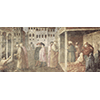
This church, begun in 1268, was completed during the second half of the 15th century (1476). It was radically transformed during the 16th and 17th centuries, and in 1771 was largely destroyed by a fire and afterwards reconstructed in its present form by 1775. The terrible blaze spared only the exterior part of the original structure, the sacresty, the Corsini chapel – designed in the Baroque period by Pier Francesco Silvani – and the Brancacci chapel. The fresco decoration of the Brancacci chapel, done by Masolino and Masaccio, was undertaken probably in 1424 but was interrupted around 1427-1428 when Masaccio left Florence to go to Rome. The work, left unfinished, was completed by Filippino Lippi after 1480. The cycle, one of the most important in Italian painting, narrates the story of human salvation made possible by the sacrifice of Christ and realized by the church through Saint Peter. In his frescoes Masaccio gave a marvelous rendering of perspective, which he studied in that period along with Brunelleschi and Donatello, and which was afterwards theorized and put into practice by, among others, Leon Battista Alberti and Piero della Francesca.
During the same period the church was also a center for the staging of episodes from the New Testament, with the employment of so-called "engines", which were complex mechanisms and lighting systems designed to enliven these sacred dramatizations. We find mention of the representation at Santa Maria del Carmine of the Ascension and of other similar plays in the 15th-century descriptions of the Russian prelate Abraham of Soudzal and again in the 16th century in the works of Vasari (Vita del Cecca and Vita di Filippo Brunelleschi) and Niccolò Frabbrini. These sources provide rare testimony about the technical means used in theatrical productions of that era.
It should be noted that from the time of Galileo’s sojourn in Padua, the family home was located within the parish of Santa Maria del Carmine. His sister Virginia Galilei probably resided there with her husband Benedetto Landucci and their mother Giulia Ammannati, who was buried in that very church in 1620.
(Nicoletta Baldini)
About 2 km. from the Church of Carmine, proceeding along Via dei Villani and Via di Bellosguardo, you reach Villa dell’Ombrellino. Nestled on the hillside of Bellosguardo, it was Galileo’s home from 1617 to 1631, and its favorable position enabled him to make numerous observations with his telescope.
.
Already documented in the late 14th century, the villa belonged to the Segni family until the mid 18th century. It was originally called "Villa di Bellosguardo", from the name of the hill where it is located, but its name changed when its new owner, countess Teresa Spinelli Albizi, during the course of renovation in 1815, had a little iron pavilion in the Chinese style and in the shape of an "ombrellino" (small light umbrella) placed in the garden. In 1874, the property was purchased by the Zoubow family who united it with the adjoining Villa della Torricella, transforming the two gardens into a large romantic park abounding in exotic species including palms, bamboo, cedar and ginkgo biloba. In the first half of the 20th century, the portion of park that looks towards Florence was transformed into an Italian garden by British architect Cecil Pinsent.
The villa, which had numerous illustrious guests, was inhabited from 1617 to 1631 by Galileo Galilei who here wrote Il Saggiatore (The Assayer) and the Dialogo sui massimi sistemi (Dialogue Concerning the Chief World Systems), before moving to Arcetri. Galileo did not like to live in the city, and always lived between Bellosguardo and Arcetri. Between 1616 and 1617 at Bellosguardo, he performed a series of astronomical observations on the mean motions of the satellites of Jupiter (the Medicean planets) and elaborated the relative Tables. Together with Benedetto Castelli, he also observed the stars in the tail of the constellation of Ursa Major.
Inside the entrance loggia, a bust and commemorative plaque recall the great Pisan scientist’s sojourn. The villa has recently been restored, and hosts various events and a congress centre.
(Graziano Magrini)
Galileo was often a guest at the nearby Medici Villa of Marignolle, which Grand Duke Francesco I had bequeathed to Don Antonio de’ Medici (his and Bianca Cappello’s illegitimate son).
Confiscated from Lorenzo di Piero Ridolfi in the 16th century by Francesco I de’ Medici who assigned it to don Antonio de’ Medici, son of Bianca Cappello, the villa was enlarged on a project by Bernardo Buontalenti. Situated in the middle of a vast meadow, the villa is surrounded by crenellated walls which give it, still today, the traditional look of a fortified house. In the first half of the 17th century, the villa with its adjoining farm was sold to the Capponi family who maintained the original aspect intact.
Galileo Galilei was a guest at this villa several times, as can be gathered from the letters written to him by Antonio de’ Medici on October 31, 1611, and by French philosopher Marin Mersenne on February 1, 1629.
(Graziano Magrini)
In 1631 Galileo rented Villa "Il gioiello" to live close to his daughters who were nuns in the next-door Convent of San Matteo in Arcetri. After his trial and condemnation in 1633 he was confined there under house arrest. Situated in Pian de’ Giullari, you can reach it by taking Via delle Campora eastward to Viale del Poggio Imperiale and turning left on Via Evangelista Torricelli which then becomes Via del Pian dei Giullari.
The villa, the origin of which seems to date to the 14th century, was rebuilt in the 16th century. The name "Gioiello" (Jewel) indicated the favourable location of the property, situated westwards in the hills of Arcetri. In remembrance of Galileo Galilei who here lived the last years of his life, the facade conserves a bust from 1843 and two plaques (1788 and 1942).
It was Galileo’s daughter, Virginia, who informed her father in August 1631 of the possibility to rent the villa adjoining the monastery of San Matteo in Arcetri (both of Galileo’s daughters had become nuns in this monastery: Virginia in October 1616 with the name of Suor Maria Celeste, and Livia in October 1617 with that of Suor Arcangela). Galileo stipulated the lease contract in September 1631. As his biographer Niccolò Gherardini narrates, Galileo «would spend many continuous hours in his garden, tending with his own hands all the pergolas and rows of grapevines, with such symmetry and proportion that it was a worthy thing to see».
After being condemned by the Tribunal of the Holy Office, Galileo was the guest of Archbishop Ascanio Piccolomini in Siena, as it was unwise to proceed to Florence, stricken by the plague. On December 1, 1633, the Congregation of the Holy Office permitted the scientist to return to "Gioiello", but he was forbidden to receive guests to discuss scientific topics with. In the last days of the year, he received the visit of the Grand Duke of Tuscany Ferdinando II de’ Medici. Only in January 1639, given his precarious health conditions, was he permitted to host the young Vincenzo Viviani who, three months before the death of the Pisan scientist, was joined by Evangelista Torricelli.
Here Galileo ended his days, assisted by his son Vincenzo, Torricelli and Viviani. In his Racconto Istorico della Vita del Sig.r Galileo Galilei, Viviani describes the maestro’s final moments: «With the supervention of a very slow fever and palpitations of the heart, after two months of an illness that little by little consumed his spirits, on Wednesday, January 8, 1641 ab Incarnatione [1642], at four in the morning, and at the age of seventy-seven years, ten months and twenty days, with philosophical and Christian constancy, he gave up the soul to the Creator, sending it, as much as faith agrees, to enjoy and more closely admire the eternal and immutable wonders that fragile artifice, great thirst and impatience had permitted the eyes of we mortals to approach».
(Graziano Magrini)
On the way back to Florence center going toward Ponte alle Grazie, you come after about 5 km. to Galileo’s House in Costa San Giorgio, which he purchased in various phases from 1629 to 1634. While Galileo himself lived there but little, his son Vincenzo and his wife Sestilia Bocchineri made it their long-term residence. During his period of confinement at Arcetri, Galileo was denied his many requests to move there to receive proper medical care in Florence, though in the end he was able to obtain permission.
On Costa San Giorgio, in the populace of Santo Spirito, is the location of the houses that the Galilei family purchased in the period between 1629 and 1634. The first house was sold by Iacopo Bramanti Boschi to Vincenzo on December 20, 1621. The second house was sold by Iacopo Zuccagni to Galileo on August 18, 1634. There was a dispute with Zuccagni around this house, because he did not acknowledge Galileo possession until the decisions of the Supreme Magistrate. Today, on the facade, we can see the coat of arms of the Galileo family and a portrait of the Pisan scientist.
In May 1633, due to an epidemic of plague that had gone rampant through Florence for quite some time, the Madonna of Impruneta was carried in procession through the city. Along the streets travelled by the image, displays with torches, lamps, altars and fountains were set up. Galileo’s house on Costa San Giorgio was decked with an altar inside the door and a fountain that was so original - the most beautiful of its kind - that it was thought to be an invention of Galileo himself. In the same period, the scientist was in Rome in the middle of the trial which was to end with his condemnation by the Court of the Inquisition.
On Costa San Giorgio stood the Convent of San Girolamo, also known as the Convent of San Giorgio, where a daughter of Galileo’s sister Virginia was a nun with the name of Suor Arcangiola. Maria Virginia, daughter of his grandson Vincenzo, was also a nun here with the name of Suor Maria Olimpia. All the expenses incurred by Galileo for the convent of San Giorgio and for his great granddaughter Virginia Landucci between 1640 and 1641 were recorded.
(Graziano Magrini)
Crossing Ponte alle Grazie, you come to one of the most prestigious churches in Florence, the Basilica di Santa Croce. Among the numerous sepulchres housing the remains of illustrious persons who have made this monument complex so famous there is also Galileo’s. However, it only dates from the 1700’s, since at his death the Pope prevented any celebrative monument from being erected.
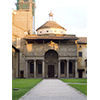
Construction of the church of Santa Croce began in 1295 on the site of a pre-existing Franciscan church. The religious centre became the hub of spiritual, social, productive and cultural life of the entire district. The church became an extraordinary melting pot where artists like Giotto, Donatello and Brunelleschi worked. The presence of funerary monuments of illustrious personages, including several scientists, makes Santa Croce the "pantheon of the Italians", celebrated by Ugo Foscolo in his Sepolcri.
After the death of Galileo Galilei (1642), his remains were placed in a little room beneath the bell tower of the church of Santa Croce, adjoining the Chapel of Saints Cosma and Damiano, while awaiting the construction of a monumental sepulchre. The project, however, encountered the hostility of church authorities who pointed out to Grand Duke Ferdinando II de’ Medici the inopportuneness of erecting a monument to a man condemned by the Church. In 1632 in fact, Galileo had published in Florence his Dialogo sopra i due massimi sistemi del mondo [Dialogue Concerning the Two Chief World Systems], an overtly Copernican work. The Dialogue had been sequestered and the scientist summoned to Rome by the Holy Office. The trial ended with the condemnation of Galileo who was forced to abjure and «quit the false opinion that the sun is the centre of the world and that it does not move, and that the earth is not the centre of the world and that it moves». Despite opposition, the youngest disciple of the Pisan scientist, Vincenzo Viviani, devoted enormous energy to the project for a monumental sepulchre. A worthy tribute to the scientist would have permitted the total recovery of Galilean thought in the official cultural debate. Viviani, however, did not succeed in surpassing the resistances of ecclesiastic environments. Only at the end of the reign of Giangastone de’ Medici, almost a century after Galileo’s death, was it possible to inaugurate the monumental sepulchre. On March 12, 1737, the mortal remains of Galileo and Viviani, along with an unexpected third body, of a woman, probably Galileo’s beloved daughter Suor Maria Celeste, were carried in a procession from the first burial site to the new sepulchre. The sculptural layout presents an iconographic apparatus that alludes to the Pisan scientist’s greatest intuitions. On either side of the urn are the statue of Geometry, sculpted by Girolamo Ticciati, which celebrates Galilean studies on the inclined plane and on falling bodies, and that of Astronomy, the work of Vincenzo Foggini, which shows the Galilean discovery of sun spots. The sepulchre is surmounted by a bust of Galileo holding a telescope in hand. Above the monument, the coat of arms of the Galilei family.
Inside the basilica, among tens of sepulchres of eminent personalities in every field of human activity (from Michelangelo to Vittorio Alfieri, from Gioacchino Rossini to Ugo Foscolo), we also find those of Fossombroni (a decisive figure in the complex reclamation of Maremma, carried out by Leopold II), Eugenio Barsanti, co inventor with father Felice Matteucci, of the first prototype of the internal combustion engine (the engine utilised the internal combustion of gases to produce motive power), and of physicist Leopoldo Nobili.
The monumental complex of Santa Croce is a significant place for science also for the astronomical fresco in the Pazzi Chapel, designed by Brunelleschi, that portrays a nocturnal sky, similar to the one in the Old Sacristy of San Lorenzo.
(Graziano Magrini)
Another church probably linked to events in Galileo’s life is Santa Trinita, 1 km. away from Santa Croce, where, according to Vincenzo Viviani, Galileo completed his first scholastic studies among the Vallombrosans, although other sources suggest a stay at the Vallombrosa Convent.
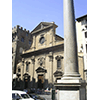
This basilica, founded by the Vallombrosan Order, was built during the 11th century. It was enlarged in the Gothic style during the first thirty years of the 14th century and later on from the end of that century till about 1405. The outside facing in hard sandstone, designed at the end of the 16th century (1593-1594) by Bernardo Buontalenti, displays a double order of composite pilasters, and at its upper central point there is a round window.
The interior, with its Gothic plan in the form of an Egyptian cross, was revamped during the 17th century. It consists of three naves separated by pilasters, with five chapels on either side, four at the end and a square apse. It houses countless artworks, among which these should be noted: in the right-hand nave the fourth chapel is decorated with frescoes by Lorenzo Monaco, painted 1420-1425, and with a wood-panel painting of the Annuciation by the same artist; and in the right transept there is the Sassetti chapel, frescoed by Domenico Ghirlandaio and his workshop between 1483 and 1486 with Episodes from the Life of Saint Francis of Assisi.
In one of the manuscript versions of his Racconto istorico della vita di Galileo Galilei Vincenzo Viviani writes that young Galileo «learned the precepts of logic from a Vallombrosan teacher of S. Trinita», although this detail does not appear in the printed text. Whether Galileo completed his first studies in Florence at Santa Trinita or at the Vallombrosa Monastery was apparently a debated issue even among his contemporaries.
(Nicoletta Baldini)
To end our itinerary we suggest a visit to the Convent of San Marco, which today houses the Museum of San Marco, the place from which the Dominican friar Niccolò Lorini sent a letter of denunciation against Galileo to the Holy Office, which found its way among the documents of his trial in 1616.
The Convent of San Marco owes its present appearance to the reconstruction of an earlier Medieval convent performed by the architect Michelozzo under commission to Cosimo the Elder, between 1436 and 1446. Three years after becoming state property in 1866, it became headquarters of a Museum housing many masterpieces, including the world-famous fresco cycle by Beato Angelico and most of his works on wood.
Though principally important from the historical-artistic viewpoint, the Museum also presents numerous elements of scientific interest: among the works by Angelico, it is only proper to cite the paintings conserved in the Pilgrims’ Hospice which portray the two physician saints, Cosma and Damiano, who are easily recognisable by their cassocks, red hats and the round box containing medicines. Exemplary among these is the painting on wood of the "Healing of the Deacon Justinian", in which the two saints are depicted in the act of transplanting the leg of a "moor" in replacement of the deacon’s diseased leg. Extremely interesting for the geographic disciplines is instead the San Marco Altarpiece, realised between 1438 and 1440: here, the Christ Child holds a terrestrial globe that modern scholars of ancient cartography have interpreted as a reference to the then known dry lands.
On the right wall of the passageway that connects the cloister of Sant’Antonino with the stairway that leads to the upper floor, the visitor can observe a cycle of four paintings by Jacopo Vignali, realised on the occasion of the plague of 1622-23 and intended for the convent "Spicery" (pharmacy). These paintings portray the theme of the disease and care of the body and spirit. On the opposite wall is the "Miracle of Saint Paul", a seventeenth-century work by Giovanni Bilivert, which presents an interesting curiosity: resting on the nose of one of the secondary figures is, in fact, a pair of eyeglasses, an object already widespread in the 16th century, and usually depicted in works of art as a symbol of knowledge and science.
The tie with science is even stronger, however, on the upper floor of the convent where, in addition to the cell of Cosimo with the fresco of the Adoration of the Magi in which there is a figure holding an armillary sphere, we also find the monumental Library by Michelozzo. The first public library of the Renaissance, it was born to conserve the books of humanist Niccolò Niccoli which were joined, by order of Cosimo the Elder, by the major texts of Medieval theological, legal and scientific knowledge. In the following centuries, the importance of the library, continually enriched with new volumes, was testified by mathematician and philosopher Gottfried Wilhelm von Leibniz who, in 1689, was able to consult a text of mathematical logic (the Liber calculationum by Richard Swineshead), which he had sought elsewhere in vain. The remains of a wind-rose, carved on a layer of plaster at the height of the library’s seventh western bay, indicate the former location of the collection of scientific books, which is also testified by a sixteenth-century catalogue of the convent’s works.
The San Marco complex is also tied to an episode that directly involved Galileo Galilei. In 1615, the Dominican Niccolò Lorini in fact denounced Galilei to the Inquisition, sending a copy of a letter in which the Pisan mathematician defended the validity of the Copernican theories. The Fathers of San Marco accused Galileo of having formulated «dubious or impudent» affirmations.
(Elena Fani)
****************************
Texts by Sara Bonechi
English translation by Edward Tosques
Last update 17/ott/2008



 = libraries and archives
= libraries and archives  = scientific research centers
= scientific research centers  = memorial places of scientists
= memorial places of scientists = public health places
= public health places = places of science and worship
= places of science and worship = places of technology
= places of technology  = museums and collections
= museums and collections  = villas and gardens of science
= villas and gardens of science



